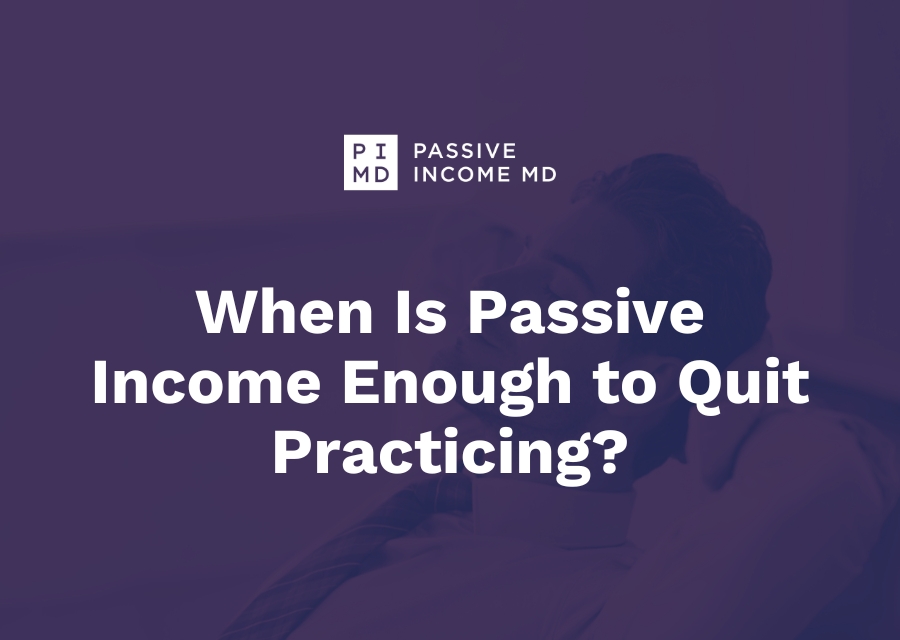That’s a question I hear often from physicians exploring financial freedom.
“How much passive income do I really need before I can walk away from medicine?”
The answer isn’t one-size-fits-all… but let’s break it down so you can find your number.
Disclaimer: This article is for informational and educational purposes only and does not constitute financial, legal, or investment advice. Any investment involves risk, and you should consult your financial advisor, attorney, or CPA before making any investment decisions. Past performance is not indicative of future results. The author and associated entities disclaim any liability for loss incurred as a result of the use of this material or its content.
Why This Question Matters (Even If You Don’t Want to Quit)
Truth is, most doctors don’t really want to walk away from medicine. We went into this profession to help people, and many of us still love the clinical side.
But what we don’t love?
- Endless call shifts
- EMR and administrative overload
- The feeling of being stuck
The real goal isn’t quitting.
The goal is having the freedom to choose.
- Choose to work part-time.
- Choose to take a sabbatical.
- Choose to say “no” to burnout-inducing schedules.
That’s the power of passive income.
Step 1: Know Your “Why” and Lifestyle Goals
Before running numbers, get clear on:
- What do you want your life to look like?
- Why do you want more time or financial freedom?
- What would change if you didn’t have to work?
Examples:
- Want to spend more time with kids? → You may only need to reduce by 1–2 shifts/week.
- Want to do medical mission work or travel? → You’ll need to cover that financially.
- Want to retire early? → You’ll need full expense replacement.
Your “why” determines your target income.
Step 2: Calculate Your Monthly Expenses
Let’s get into the math.
Here’s a pretty realistic breakdown for a typical physician household living in a major metro area:
| Category | Monthly Expense |
| Housing (mortgage/taxes/insurance) | $6,000 |
| Food & groceries | $1,200 |
| Utilities & home services (internet, power, etc.) | $800 |
| Transportation (car, gas, insurance) | $600 |
| Health insurance & medical expenses | $900 |
| Childcare / private school tuition | $2,500 |
| Travel & hobbies | $1,500 |
| Miscellaneous (shopping, dining out, etc.) | $1,200 |
| Total | $14,700/month |
That means your annual lifestyle cost is:
$14,700 × 12 = $176,400/year
This is the baseline number to cover your current lifestyle through passive income.
Tiered Passive Income Targets (Updated)
| Tier | Goal | Monthly Income Needed |
| Tier 1: Relief | Cover essentials (50% of lifestyle expenses) | ~$7,500 |
| Tier 2: Freedom | Replace full monthly lifestyle | ~$14,700 |
| Tier 3: Abundance | Add extra margin, legacy, and giving | $17,000+ |
Tip: Start with Tier 1. Even covering 50% gives you leverage to work less and design your ideal schedule.
Step 4: Understand the Numbers Behind Passive Income
Let’s say you want $10,000/month in passive income ($120,000/year). Here are 3 different ways to get there:
1. Real Estate Income
Let’s say each rental property unit nets you $400/month after all expenses.
$10,000 ÷ $400 = 25 units
So you’d need roughly 25 rental units (single-family homes, duplexes, or multifamily doors) to hit that goal.
Alternatively, if you invest in syndications:
- $100,000 in a deal with 8% annual cash flow = $8,000/year
- You’d need $1.5 million invested to generate $120,000/year
2. Dividend Stocks or REITs
Let’s say you invest in a dividend portfolio that yields 4%.
- $120,000 ÷ 0.04 = $3 million needed
This is why real estate is often favored, higher cash flow with less capital.
You only need to build 3–4 streams like that to hit your $10K/month goal.
Step 5: Create Your “Walkaway” Target
You now know your:
- Expenses
- Lifestyle goals
- Passive income vehicles
Now set your walkaway number.
For example:
“I want to cover 70% of my $11,000 monthly expenses with passive income so I can drop to part-time. That means I need $7,700/month, or $92,400/year.”
Now you have a clear, actionable target.

Subscribe to receive the 7 Steps you can follow to achieve Financial Freedom
If financial freedom is your goal, there’s no better time to get started than right now.
Unlock actionable steps that you can take every day to fine-tune your goals, discover your interests, and avoid costly mistakes on your financial freedom journey.
Final Thoughts: You Don’t Need to Quit. You Just Need Options.
Let me be clear:
This journey isn’t about leaving medicine. It’s about leaving behind burnout, pressure, and lack of control.
Passive income creates space to:
- Practice medicine on your terms
- Be present with your family
- Explore passions and make an impact
Whether your number is $5K/month or $15K/month, the path starts with clarity, and consistent, intentional action.
Want to Calculate Your Number?
![[PIMD] Passive Income Goal Planner](https://passiveincomemd.com/wp-content/uploads/2025/08/PIMD-Passive-Income-Goal-Planner-724x1024.jpg)
Download our free Passive Income Goal Planner (PDF) to:
- Tally your expenses
- Choose your freedom tier
- Identify your ideal passive income strategies
Quick Recap
- Passive income lets you design your ideal lifestyle.
- Start by understanding your expenses and why.
- You don’t need to replace 100% of your income to reclaim your time.
- Real estate, business, and dividend portfolios are powerful tools.
- Aim for progress, not perfection. Even $1,000/month is a game-changer.
If you enjoyed this post, be sure to share it with a friend or colleague who needs to hear it.
And if you’re ready to take the next step, join our free community of physicians building financial freedom together.
What’s your walkaway number? Drop it in the comments. I’d love to hear!
Were these helpful in any way? Make sure to sign up for the newsletter and join the Passive Income Docs Facebook Group for more physician-tailored content.
Peter Kim, MD is the founder of Passive Income MD, the creator of Passive Real Estate Academy, and offers weekly education through his Monday podcast, the Passive Income MD Podcast. Join our community at the Passive Income Doc Facebook Group.
Further Reading

